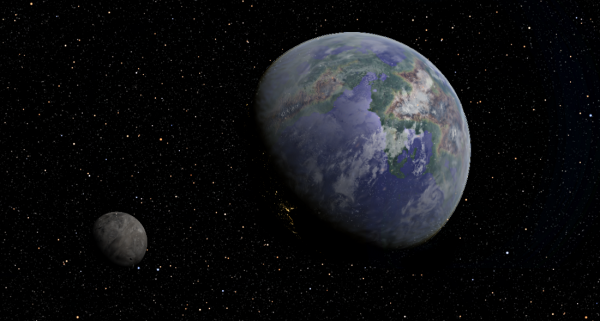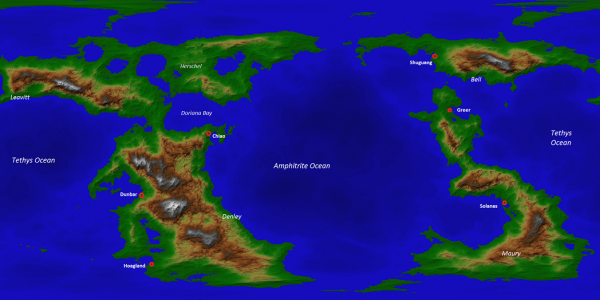BY LETTER
Hypatia
Galactography > Regions of Space > Middle Regions/Hinter-regions
Galactography > Systems and Worlds > Systems & Worlds G - H
Galactography > Systems and Worlds > Systems & Worlds G - H
Important all-female Parthene colony world | |
 Image from Steve Bowers | |
| Hypatia and its moon Aedesia | |
Star: HD 129777
Distance from Sol: 193 ly
Class: G3v
Luminosity: 1.19 x Sol
Constellation: Circinus
Planet: Hypatia
Orbital Period: 1.1yr
Semimajor Axis: 1.09 au
Type: Terraformed Eugaian
Diameter: 12180 km
Moon: Aedesia
Diameter: 2626 km
Semimajor Axis: 227979 km
Planet: Arsinoe
Type: warm neptune
Semimajor Axis: 0.123 au
Diameter: 47917 km
Planet: Selene
Type: Hermian
Semimajor Axis: 0.212 au
Diameter 4286 km
Planet: Cleopatra
Type: eujovian
Semimajor Axis: 2.65 au
Diameter: 154700 km
+43 moons
Planet: Berenice
Type: cryojovian.
Semimajor Axis: 5.938 au
Diameter: 45449 km
+17 moons
The all-female clade known as Clade Parthene was created in the Interplanetary age and survived the Technocalypse and subsequent Dark Age in near-isolation in their colony on the asteroid 5 Astraea. During the First Federation they were deeply involved in efforts to map and colonise the local Galaxy, and in due course acquired enough resources to send out their own colony mission. The ship was near completion in 1520 when the first Conversion Drives became available; the Parthenes quickly reconfigured their ship (the Carolyn Porco) and set off for their chosen star a decade later. As a very early example of this type of vessel the Porco was only capable of half the speed of light, somewhat slower than examples built in subsequent eras.
HD 129777 is 193 ly from Sol, and at the ship's cruising velocity the journey lasted more than 280 years, finally arriving in 1819 AT. The Astraean astronomers had detected a very Earth-like planet in this system, which they had named Hypatia after the Alexandrian astronomer of the 15th century BT. The colonists had hoped that this world would pose few problems for terraformation; however several problems with trace elements and weather feedback systems arose and caused significant delays. The planet was finally declared habitable in 2530, despite some problems remaining in the floodplains of Herschel in the northern continent. By this time most of the Parthenes had modified themselves in order to tolerate the gravity of the new world; after living for so long in the low gravity environment of Astraea, the women were not used to living on the surface of a planet.
Not all of the colonists chose to move to their new world. Many opted to live on Aedesia, the sandy moon of Hypatia, or on the moons of Berenice and Cleopatra and among the scattered asteroids. A significant contingent decided to found new colonies, and rebuilt the Porco with an upgraded conversion drive. This group went on to found the important Parthene colony of LeGuin as well as the more distant worlds of Cherryh and Atwood.
The Hypatians developed an agrarian society on their new world, with most of the population involved in growing food crops and biotech products. Despite the relatively humble conditions most citizens lived in the world had a sophisticated research and development infrastructure and comprehensive communications network. When the world was first colonised most Parthenes were Mortalists, preferring to avoid backup technology and uploading, although many lived for several centuries (a Hypatia year being 10% longer than an Earth year). During the Second Federation era an increasing number of individuals began to upload themselves into the great Hypatia web, where they became advisors to the various national administrations, and intermediaries between the people of this world and the rest of the Terragen Sphere.
Hypatia found itself near the disputed territory between the Negentropy Alliance and the NoCoZo during the Version War; many of the Parthenes had little sympathy for the legalistic empire of the Negentropists, which was often viewed as paternalistic and overly masculine. The freedom-loving NoCoZo worlds were more appealing, although tales of capitalistic exploitation (which may or may not have been accurate) gave some cause for doubt. The only wormhole in the system was connected to the NoCoZo system of Zhuo-lian, so most of the trade in the system (largely biotech specialities) was with that empire.
The Hypatians decided to remain neutral, but this was complicated by the close links with the NoCoZo; in the event several private companies of women-at-arms left the system to fight the Negentropists, with some distinction. In 4480 the stargate was closed by the Nexus transapients, and soon after Zhuo-lian was overwhelmed by the 67th Negentropist fleet.
Hypatia was largely isolated for the next six hundred years, and during this time the Parthenes of this world became even more inclined to an isolationist stance. In due course a few ships returned from the war, making their way though interstellar space; these battle-hardened veterans became the heart of a new Hypatia Defence Corps. The wormhole to Zhuo-lian (now a NoCoNeg world) was finally reopened by the ComEmp, which also opened new wormholes to LeGuin and the other surviving Parthene worlds, and (despite their differences) these worlds forged an alliance of their own.
Clade Parthene on Hypatia
The Parthene clade was created with the aim of forming a society without men, since the founders considered that male aggression and privilege was responsible for many of the problems they perceived in the culture of the Solar System in the Interplanetary Age. Even though many cultures of that time practiced various forms of sexual equality, many others did not, and the Parthene Founding Mothers opted to remove the problem of physical and psychological dimorphism from their new clade. The first Parthenes were all superbright female humans capable of parthenogenic reproduction, cloning themselves at will to have daughters that were physically identical to themselves. With some amusement they found that their daughters were often quite dissimilar in temperament and lifestyle to themselves, with new ways of looking at the world; but this degree of diversity was not enough to satisfy subsequent generations, so the Parthenes adopted various kinds of ova fusion to allow sexual reproduction to occur without any male input.On arrival at HD 129777 the Parthenes decided to declare their system a male-free zone; no human males were allowed to enter the system, and when the original wormhole was opened, they requested that only female, neut or asexual traders were allowed to enter the system. The Parthenes preferred to use domesticated animals in their agrarian activities, and all these were genetically modified to become parthenogenic females. Gradually they began to establish an all-female biosphere, with even wild animals modified in this fashion.
In due course the Parthenes became specialised in biotechnology and geneering, creating new food crops including a range of intriguing decorative plant-like organisms that provided sustenance, refreshment and mild hypnogogic experiences. The use of these plants developed into a ritualistic activity with priestess-guides who administered the herbs and led the communicant into states of altered awareness and lucid dreaming. This ritual was adopted by the religion of Dianic Wicca, increasingly popular on this world.
By the Second Federation Era the Parthenes were starting to apply this geneering and biotechnology technology to themselves; one group became largely devoid of female sexual attributes, becoming similar to neuts on other worlds , only developing them during the reproductive cycle; others became increasingly male-like in their appearance and behaviour, like a ferm, except that they could produce a form of sperm-analog which contained only female genetic material. The most common phenotype on this world resembled (and was very close genetically to) an ordinary baseline human female, but many women with this phenotype periodically modified their appearance somatically to become a neut or ferm at will, often adopting the ferm body-type when they wished to conceive a child sexually rather than through parthenogenesis.
 Image from Steve Bowers | |
| Hypatia - click for larger image | |
A few Parthenes even retro-engineered themselves into true baselines, who could only reproduce with ferms using female pseudosperm. These formed a distinct group, mostly found in Eastern Maury, who eschewed most high technology and lived lives modelled on records of the Agricultural Age of Old Earth. The most significant biotechnology used by this group was the treatment that modified half of them into ferms. Long after the rest of Hypatia adopted backup technology and resleeving, the Maury Basewomen remained mortalists, with short lives and largely with nuclear families. However the women and ferms of this region frequently leave their homeland to join the rest of Hypatian society, a migration which is very roughly balanced by women from elsewhere who choose to adopt the Basewoman lifestyle.
The Parthenes were geneered with the goal of reducing or eliminating male aggressive traits in the new clade; however Hypatia has not been free of conflicts in its long history. Disagreements (some escalating into minor wars) have been fairly common between heteromorph factions who periodically change their bodyshape over time and the Basewomen (or their sympathisers) (who do not).
One conflict in 7888 occured between certain hi-tech factions based in Chaio who wished to expand their commercial operations to the other planets and moons, a move which was opposed by the Outworlds Alliance, a grouping from Cleopatra and Berenice. This culminated in a blockade of Hypatia by the outworlders, which was finally broken by the Hypatia Defence Corps (which had previously remained impartial).
Meldroom Tech
Parthenes consider themselves and their society to be objectively different from societies that include male humans elsewhere; they claim to have superior emotional intelligence and linguistic ability, and enhanced empathic abilities. Since nearly every other human clade in the Terragen Sphere has also modified itself to a greater or lesser extent, the comparison that once seemed valid in the Interplanetary Age is less clear cut in the Current Era. In particular many clades have enhanced their empathic and linguistic capabilities to equal or even surpass those of the Parthenes.However they are very proud of their communication skills, and particularly in the cities of Denley and Bell sophisticated neurotech networks have been established which allow individuals to share thoughts, feelings and experiences. One particularly effective system is the Meldroom, a shared exoself virchspace that allows two persons to combine specially edited versions of their consciousness. After the meld both individuals can remember the shared memories and feelings of the other. Some users of this technology claim that the most interesting part of the process is trying to work out afterwards what the other participant has edited out of the meld, by examining the gaps in the shared memories.
The Current Era
In the last two thousand years a limited amount of non-female immigration has been permitted, starting with neuts, ferms, herms and heteromorph males presenting as females, mostly from the nearby NoCoNeg worlds. True male humans were first permitted to enter the system in 9001, at first only homosexual males who formed a small ghetto in Dunbar, but this arrangement was widely seen as arbitrary and unfair, so the women finally began to allow all male individuals of any clade into the world from 9011 onwards.Today a limited number of males of several species have made permanent homes on Hypatia, a situation that not all Hypatians have accepted with equinamity. Some not-insignificant conflicts have occurred during the liberalisation of the last two millenia, between separatists and those who wish to become involved in the greater galactic civilisation. A small but significant contingent have left the world completely, either to live on certain separatist moons of Cleopatra, or to join the continuing effort to reterraform Atwood, a world that was devastated in the Version conflict.
Related Articles
Appears in Topics
Development Notes
Text by Steve Bowers
Initially published on 22 September 2014.
Initially published on 22 September 2014.






